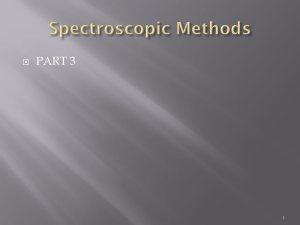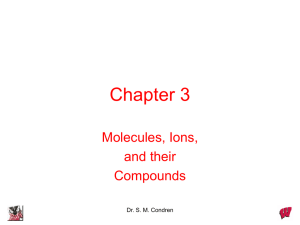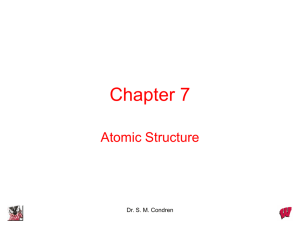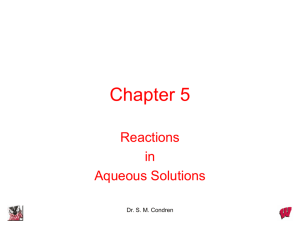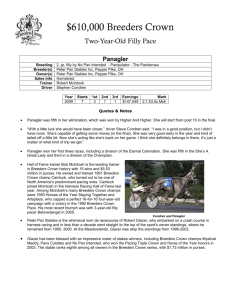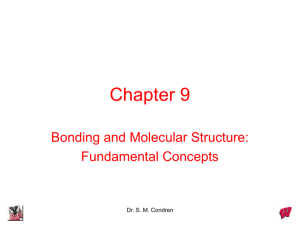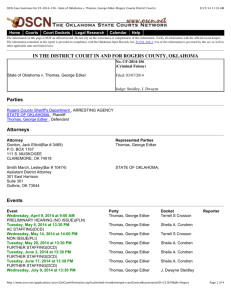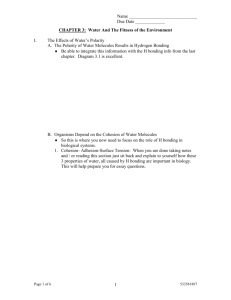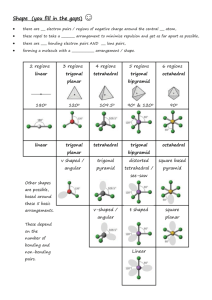Chapter 13
advertisement
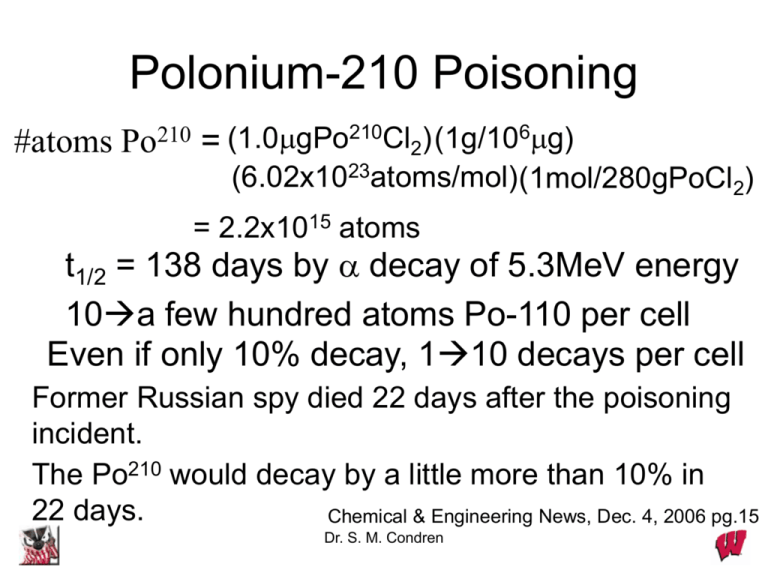
Polonium-210 Poisoning #atoms Po210 = (1.0mgPo210Cl2)(1g/106mg) (6.02x1023atoms/mol)(1mol/280gPoCl2) = 2.2x1015 atoms t1/2 = 138 days by a decay of 5.3MeV energy 10a few hundred atoms Po-110 per cell Even if only 10% decay, 110 decays per cell Former Russian spy died 22 days after the poisoning incident. The Po210 would decay by a little more than 10% in 22 days. Chemical & Engineering News, Dec. 4, 2006 pg.15 Dr. S. M. Condren Chapter 13 Intermolecular Forces: Liquids, and Solids Dr. S. M. Condren WHY? • Why is water usually a liquid and not a gas? • Why does liquid water boil at such a high temperature for such a small molecule? • Why does ice float on water? • Why do snowflakes have 6 sides? • Why is I2 a solid whereas Cl2 is a gas? • Why are NaCl crystals little cubes? Dr. S. M. Condren Inter-molecular Forces Have studied INTRAmolecular forces — the forces holding atoms together to form molecules. Now turn to forces between molecules — INTERmolecular forces. Forces between molecules/atoms, between ions, or between molecules/atoms and ions. Dr. S. M. Condren Dr. S. M. Condren Ion-Ion Forces for comparison of magnitude Na+—Cl- in salt These are the strongest forces. Lead to solids with high melting temperatures. NaCl, mp = 800 oC MgO, mp = 2800 oC Dr. S. M. Condren Covalent Bonding Forces for comparison of magnitude C=C, 610 kJ/mol C–C, 346 kJ/mol C–H, 413 kJ/mol CN, 887 kJ/mol Dr. S. M. Condren Attraction Between Ions and Permanent Dipoles •• •• water - dipole O H H + Water is highly polar and can interact with positive and negative ions to give hydrated ions in water. Dr. S. M. Condren Attraction Between Ions and Permanent Dipoles Many metal ions are hydrated. This is the reason metal salts dissolve in water. Dr. S. M. Condren Attraction Between Ions and Permanent Dipoles Attraction between ions and dipole depends on ion charge and ion-dipole distance. Measured by ∆H for Mn+ + xH2O --> [M(H2O)x]n+ - H O H + ••• Mg2+ - H O H + - H O H + ••• Na + -1922 kJ/mol -405 kJ/mol Dr. S. M. Condren ••• Cs+ -263 kJ/mol Dipole-Dipole Forces Such forces bind molecules having permanent dipoles to one another. Dr. S. M. Condren Dipole-Dipole Forces Influence of dipole-dipole forces is seen in the boiling points of simple molecules. Comp’d Mol. Wt. Boil Point N2 28 -196 oC CO 28 -192 oC Br2 160 59 oC ICl 162 97 oC Dr. S. M. Condren Hydrogen Bonding A special form of dipole-dipole attraction, which enhances dipoledipole attractions. H-bonding is strongest when X and Y are N, O, or F Dr. S. M. Condren H-Bonding Between Methanol and Water - H-bond + - Dr. S. M. Condren H-Bonding Between Two Methanol Molecules - + - H-bond Dr. S. M. Condren H-Bonding Between Ammonia and Water - + - H-bond This H-bond leads to the formation of NH4+ and OH- Dr. S. M. Condren Hydrogen Bonding in H2O H-bonding is especially strong in water because • the O—H bond is very polar • there are 2 lone pairs on the O atom Accounts for many of water’s unique properties. Dr. S. M. Condren Hydrogen Bonding in H2O Ice has open lattice-like structure. Ice density is < liquid. And so solid floats on water. Dr. S. M. Condren Hydrogen Bonding in Snowflakes Dr. S. M. Condren Dr. S. M. Condren Hydrogen Bonding in Snowflakes Dr. S. M. Condren Dr. S. M. Condren Logo for ICE Dr. S. M. Condren Hydrogen Bonding in H2O Ice has open lattice-like structure. Ice density is < liquid and so solid floats on water. One of the VERY few substances where solid is LESS DENSE than the liquid. Dr. S. M. Condren A consequence of hydrogen bonding Dr. S. M. Condren Hydrogen Bonding in H2O H bonds ---> abnormally high specific heat of water (4.184 J/g•K) This is the reason water is used to put out fires, it is the reason lakes/oceans control climate, and is the reason thunderstorms release huge amounts of energy. Dr. S. M. Condren Lower th 9 Ward of New Orleans 10 months after the storm! Dr. S. M. Condren Boiling Points of Simple Hydrogen-Containing Compounds Dr. S. M. Condren Methane Hydrate Dr. S. M. Condren Hydrogen Bonding in Biology H-bonding is especially strong in biological systems — such as DNA. DNA — helical chains of phosphate groups and sugar molecules. Chains are helical because of tetrahedral geometry of P, C, and O. Chains bind to one another by specific hydrogen bonding between pairs of Lewis bases. —adenine with thymine —guanine with cytosine Dr. S. M. Condren Double helix of DNA Portion of a DNA chain Dr. S. M. Condren Base-Pairing through H-Bonds Dr. S. M. Condren Base-Pairing through H-Bonds Dr. S. M. Condren Discovering the Double Helix Rosalind Franklin, 1920-1958 X-ray photo that led to structure James Watson (left) Maurice Wilkins, 1916 - 2004 1928Francis Crick (right) 1916-2004 1962 Nobel Prize for Physiology or Medicine Dr. S. M. Condren Forces Involving Induced Dipoles How can non-polar molecules such as O2 and I2 dissolve in water? The water dipole INDUCES a dipole in the O2 electric cloud. Dipole-induced dipole Dr. S. M. Condren Forces Involving Induced Dipoles Solubility increases with mass of the gas Process of inducing a dipole is polarization. Degree to which electron cloud of an atom or molecule can be distorted is its polarizability. Dr. S. M. Condren IM Forces – Induced Dipoles Consider I2 dissolving in ethanol, CH3CH2OH - I-I - O R H + I-I The alcohol temporarily creates or INDUCES a dipole in I2. Dr. S. M. Condren + - O R H + Forces Involving Induced Dipoles The magnitude of the induced dipole depends on the tendency to be distorted. Higher molecular weight ---> larger induced dipoles. Molecule Boiling Point (oC) CH4 (methane) - 161.5 C2H6 (ethane) - 88.6 C3H8 (propane) - 42.1 C4H10 (butane) - 0.5 Dr. S. M. Condren Boiling Points of Hydrocarbons C4H10 C3H8 C2H6 CH4 Note linear relation between bp and molar mass. Dr. S. M. Condren Intermolecular Forces Summary Dr. S. M. Condren Liquids In a liquid • molecules are in constant motion • there are appreciable intermolec. forces • molecules close together • Liquids are almost incompressible • Liquids do not fill the container Dr. S. M. Condren Liquids The two key properties we need to describe are EVAPORATION and its opposite—CONDENSATION evaporation---> LIQUID Add energy VAPOR break IM bonds make IM bonds Remove energy <---condensation Dr. S. M. Condren Liquids Distribution of molecular energies in a liquid. KE is proportional to T. At higher T a much larger number of molecules has high enough energy to break IM forces and move from liquid to vapor state. High E molecules carry away E. You cool down when sweating or after swimming. Dr. S. M. Condren When molecules of liquid are in the vapor state, they exert a Liquids VAPOR PRESSURE EQUILIBRIUM VAPOR PRESSURE is the pressure exerted by a vapor over a liquid in a closed container when the rate of evaporation = rate of condensation. Dr. S. M. Condren Measuring Equilibrium Vapor Pressure Liquid in flask evaporates and exerts pressure on manometer. Dr. S. M. Condren Equilibrium Vapor Pressure Dr. S. M. Condren Boiling Point Liquid boils when its vapor pressure equals atmospheric pressure. When pressure is lowered, the vapor pressure can equal the external pressure at a lower temperature. Dr. S. M. Condren Liquids If external P = 760 mm Hg, T of boiling is the NORMAL BOILING POINT VP of a given molecule at a given T depends on IM forces. Here the VP’s are in the order ether O C2H5 H5C2 dipoledipole alcohol O H5C2 H H-bonds water O H H extensive H-bonds increasing strength of IM interactions Dr. S. M. Condren Liquids HEAT OF VAPORIZATION is the heat required (at constant P) to vaporize the liquid. LIQ + heat ---> VAP Compd. ∆Hvap (kJ/mol) IM Force H 2O 40.7 (100 oC) H-bonds, dipole, induced dipole SO2 26.8 (-47 oC) dipole, induced dipole Xe 12.6 (-107 oC) induced dipole Dr. S. M. Condren Liquids Molecules at surface behave differently than those in the interior. Molecules at surface experience net INWARD force of attraction. This leads to SURFACE TENSION — the energy required to break the surface. Dr. S. M. Condren Liquids Intermolecular forces also lead to CAPILLARY action and to the existence of a concave meniscus for a water column. concave meniscus H2 O in glass tube ADHESIVE FORCES between water and glass COHESIVE FORCES between water molecules Dr. S. M. Condren Capillary Action Movement of water up a piece of paper depends on H-bonds between H2O and the OH groups of the cellulose in the paper. Dr. S. M. Condren Metallic and Ionic Solids Dr. S. M. Condren Types of Solids TYPE Ionic Metallic Molecular Network EXAMPLE NaCl, CaF2, ZnS Na, Fe Ice, I2 Diamond Graphite Dr. S. M. Condren FORCE Ion-ion Metallic Dipole Ind. dipole Extended covalent Phases Diagrams — Important Points for Water T(˚C) Normal boil point 100 Normal freeze point 0 Triple point 0.0098 Critical point 374 Dr. S. M. Condren P(mmHg) 760 760 4.58 218 atm Solid-Vapor Equilibria At P < 4.58 mmHg and T < 0.0098 ˚C solid H2O can go directly to vapor. This process is called SUBLIMATION This is how a frost-free refrigerator works. Dr. S. M. Condren CO2 Phase Diagram Dr. S. M. Condren Network Solids Diamond Graphite Dr. S. M. Condren Properties of Solids 1. Molecules, atoms or ions locked into a CRYSTAL LATTICE 2. Particles are CLOSE together 3. STRONG IM forces 4. Highly ordered, rigid, incompressible ZnS, zinc sulfide Dr. S. M. Condren Crystal Lattices • Regular 3-D arrangements of equivalent LATTICE POINTS in space. • Lattice points define UNIT CELLS – smallest repeating internal unit that has the symmetry characteristic of the solid. Dr. S. M. Condren Cubic Unit Cells There are 7 basic crystal systems, but we are only concerned with CUBIC. All sides equal length All angles are 90 degrees Dr. S. M. Condren Cubic Unit Cells of Metals Primitive cubic Dr. S. M. Condren Simple Cubic Unit Cell • Each atom is at a corner of a unit cell and is shared among 8 unit cells. • Each edge is shared with 4 cells • Each face is part of two cells. Dr. S. M. Condren Atom Sharing at Cube Faces and Corners Atom shared in corner --> 1/8 inside each unit cell Atom shared in face --> 1/2 inside each unit cell Dr. S. M. Condren Number of Atoms per Unit Cell Unit Cell Type SC (Primitive Cubic) BCC FCC Net Number Atoms Primitive cubic Dr. S. M. Condren 1 2 4 Atom Packing in Unit Cells Assume atoms are hard spheres and that crystals are built by PACKING of these spheres as efficiently as possible. Dr. S. M. Condren Units Cells for Metals Primitive cubic Dr. S. M. Condren Atom Packing in Unit Cells Dr. S. M. Condren Simple Ionic Compounds Lattices of many simple ionic solids are built by taking a SC (Simple or Primitive Cubic) or FCC (Face-Centered Cubic) lattice of ions of one type and placing ions of opposite charge in the holes in the lattice. EXAMPLE: CsCl has a SC (Primitive Cubic) lattice of Cs+ ions with Cl- in the center NOT a BCC (Body-Centered Cubic) because the ion at the center of the body is not the same ion as at the corners. Dr. S. M. Condren Two Views of CsCl Unit Cell •Lattice can be SC lattice of Cl- with Cs+ in hole •OR SC lattice of Cs+ with Cl- in hole •Either arrangement leads to formula of 1 Cs+ and 1 Clper unit cell Dr. S. M. Condren NaCl Construction FCC lattice of Cl- with Na+ in holes Na+ in octahedral holes Dr. S. M. Condren Comparing NaCl and CsCl • Even though their formulas have one cation and one anion, the lattices of CsCl and NaCl are different. • The different lattices arise from the fact that a Cs+ ion is much larger than a Na+ ion. Dr. S. M. Condren Face-Centered Cubic Zinc blende Diamond Dr. S. M. Condren Common Ionic Solids Magnesium silicate, MgSiO3 Dr. S. M. Condren
